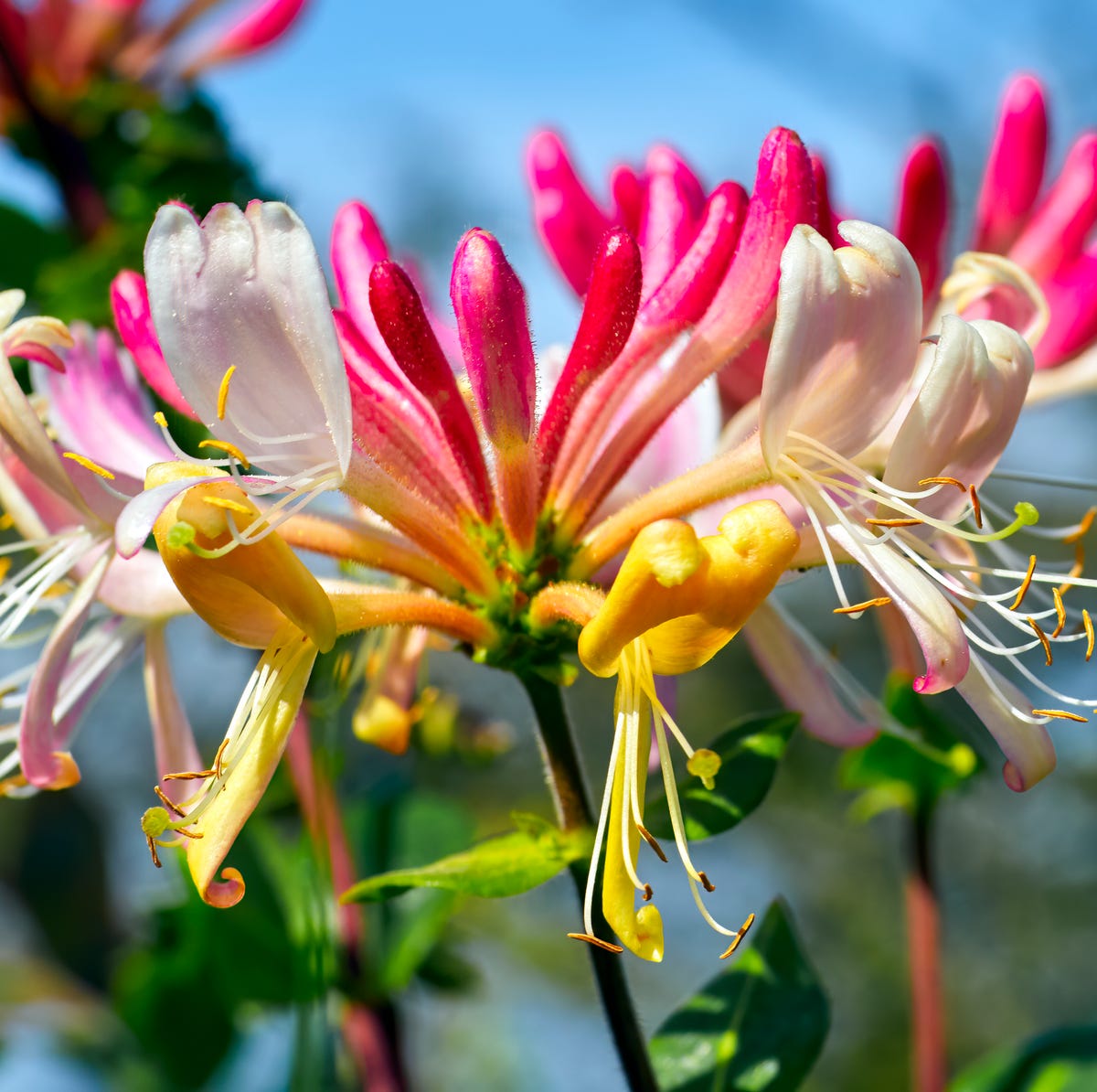Honeysuckle enchants with its sweet perfume, tubular blossoms, and wild, winding habit. Whether grown as a climber scrambling up trellises or as a bushy ground cover, it’s a plant that invites nostalgia and sensory delight. From cottage gardens to woodland edges, honeysuckle holds a timeless spot in horticulture.
More than just a pretty scent, honeysuckle symbolizes devotion and enduring love. Once established, it rewards the garden year after year with long blooming seasons, heady fragrance, and pollinator activity.

Portrait of the Honeysuckle
Honeysuckle includes over 180 species in the Caprifoliaceae family, with both evergreen and deciduous types. Common garden favorites include Lonicera japonica (Japanese honeysuckle) and Lonicera periclymenum (European honeysuckle).
- Type: Deciduous or semi-evergreen vine/shrub
- Family: Caprifoliaceae
- Common Names: Honeysuckle, Woodbine, Lonicera
Foliage and Form
Honeysuckle features oval or lance-shaped leaves, often arranged in pairs. As a climber, it twines naturally, using other plants or structures for support. Some species remain shrubby and compact.
- Height: 3–6 m (10–20 ft) climbing; 1–2 m (3–6 ft) shrub forms
- Spread: 1–3 m (3–10 ft)
- Growth Habit: Twining or bushy; vigorous in warm climates
Blooms and Fragrance
One of honeysuckle’s greatest gifts is its extended bloom period and intoxicating scent. Flowers are usually tubular, two-lipped, and appear in clusters.
- Bloom Time: Late spring through summer, sometimes into fall
- Color: Cream, yellow, pink, red, or orange
- Fragrance: Strong and sweet—especially evenings and early mornings
The Right Time to Plant, Prune, and Enjoy Honeysuckle
| Month | Planting | Flowering | Pruning |
|---|---|---|---|
| January | ❌ | ❌ | ✅ Light shaping (if needed) |
| February | ✅ Dormant shrubs | ❌ | ✅ Structural pruning |
| March | ✅ Prime time for planting | ❌ | ✅ Finish shaping cuts |
| April | ✅ | ✅ Early bloom begins | ❌ |
| May | ❌ | ✅ Peak blossoms | ❌ |
| June | ❌ | ✅ Continuous flowering | ✅ Light deadheading |
| July | ❌ | ✅ | ✅ Cut back overly vigorous stems |
| August | ❌ | ✅ Late-season blooms | ✅ Prune after flowering (late) |
| September | ✅ (container-grown) | ✅ (if reblooming species) | ✅ Clean-up and thinning |
| October | ✅ | ❌ | ✅ Light shaping if needed |
| November | ✅ (mild climates) | ❌ | ✅ Prepare for winter structure |
| December | ❌ | ❌ | ✅ Dormant cleanup |
✅ = Recommended ❌ = Not advised
Watering, Sunlight, and Environment for Honeysuckle
Watering
Honeysuckle prefers consistent moisture during establishment but becomes drought-tolerant once mature.
- When to Water: Weekly when young; as needed once established
- How Much: Keep soil moist but not waterlogged
- Watch out for: Root rot in heavy soils
Sunlight
Most honeysuckles thrive in full sun, though they tolerate partial shade. The more sun, the more abundant the flowers and fragrance.
- Ideal Exposure: 6+ hours of direct sun per day
- Shady Sites: Fewer flowers, leggy growth
Indoor vs Outdoor
Honeysuckle is best suited to outdoor conditions—gardens, fences, pergolas, or wild edges. Indoor growth is generally not recommended due to its size and vigor.
- Best Location: Outdoor trellises, walls, fences, or naturalized areas
- Avoid: Small containers, indoor environments
Temperature
Hardy and resilient, honeysuckle tolerates a range of conditions. Some species are evergreen in mild zones and deciduous in colder ones.
- Optimal Range: 10–25°C (50–77°F)
- Hardiness Zones: USDA 4–9 (varies by species)
- Protection Tip: Mulch roots in cold zones
Ideal Soil Conditions for Growing Honeysuckle
| Soil Feature | Optimal Condition | Why It Matters |
|---|---|---|
| Soil Type | Loamy, fertile | Supports vigorous growth |
| Texture | Soft, crumbly | Encourages strong root expansion |
| Drainage | Well-drained | Prevents fungal issues |
| Moisture | Moist, not soggy | Sustains foliage and blooms |
| Soil pH | Neutral to slightly alkaline (6.5–7.5) | Encourages healthy flowering |
| Fertility | Moderate | Too rich = more leaves, fewer blooms |
Common Problems & Solutions
| Issue 🐾 | Symptoms 🔍 | Solutions 🛠️ |
|---|---|---|
| Powdery Mildew 🍃 | White coating on leaves | Improve airflow, use organic fungicides |
| Aphids 🐜 | Sticky residue, distorted shoots | Spray with water or neem oil |
| Leaf Drop 🍂 | Sudden leaf fall | Overwatering or shock; assess drainage |
| Sparse Flowers 🌸 | Lots of growth, few blooms | Prune properly and increase sunlight |
| Overgrowth 🌿 | Unruly tangles and choking vines | Annual pruning after flowering |
Honeysuckle rewards gardeners with its intoxicating scent, classic charm, and versatile growth. Whether climbing a rustic fence or trailing from a trellis, it invites wildlife, fragrance, and whimsy into your garden. With just a little maintenance, this vine will bloom reliably and infuse your landscape with natural beauty and nostalgia.